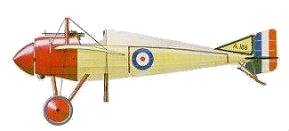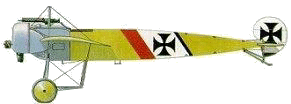On
April 1, 1915, French pilot Roland Garros shot down a German Albatros
airplane. Although this was not the first air-to-air kill, Garros’
airplane, a Morane Parasol, was the first airplane that was modified
specifically for the purpose of aerial combat. Working with designer
Raymond Saulnier, Garros had developed reinforced propeller blades that
deflected bullets from a forward-firing machine gun (which made hitting
the target easier). Over the next several weeks, Garros and his airplane
scored three more victories until he was forced to land the plane in
Germany territory. He was taken prisoner before he could burn the
airplane, which fell into the hands of the Germans.

A crashed German Albatros
fighter airplane.
Garros
and his airplane ushered in a new era of aviation—both the age of aces
and the first aviation arms race. For the remainder of the war, the
combatants competed daily for air superiority in order to fly over the
enemy’s trenches un-harassed--photographing movements, dropping bombs,
and strafing troops. But to gain air superiority, an army’s aerial wing
had to have more airplanes and the best pilots. Governments spent the
war pushing their designers to build planes that would be faster and
more manoeuvrable than the enemy’s. This arms race, combined with
advances in personnel training and aerial combat tactics, meant that
when World War I ended on November 11, 1918, the airplane’s development
had been accelerated to the point where it had become an integral part
of military and civilian life.
But it
all began with Garros and his Morane Parasol.
Garros' Innovation
During the month before the outbreak of the war,
Raymond Saulnier had been working on an interrupter gear that would
allow a machine gun to be fired through the propeller arc. He had grown
impatient with hang-fire failures so he attached steel deflection plates
on the propeller where the bullets passed through the arc. The military
lost interest in his idea once the war started and made Saulnier return
the machine gun he had borrowed. After a few months into the war, all
the pilots were unanimous in their desire for fixed machine guns facing
forward that they could shoot in the direction they were flying.
Lieutenant Roland Garros, who had been a famous stunt pilot before the
war, came to Saulnier and had steel deflector plates attached to his
propeller blades and a fixed machine gun mounted in front of the
cockpit. The interrupter gear was not installed, Garros relying on the
steel plates to ward off the bullets that hit the airscrew. At the end
of March Garros took to the air, and in just over a fortnight he had
shot down five German planes. On April 19, though, he was brought down
by enemy ground fire while strafing an infantry unit near Coutrai. His
attempts to set fire to his plane (as all pilots did when they crashed
landed in enemy territory, so the enemy could not get their hands on
their technology) were unsuccessful and his modified airscrew was
quickly in the workshop of Anthony Fokker.
 Morane-Saulnier
Morane-Saulnier
 Fokker Eindecker
Fokker Eindecker
Anthony Fokker improves Garros' Innovation
The problem of perfecting a machine gun that would
synchronize its firing with the rotation of the propellers was the
assignment given to Anthony Fokker. In two days the Dutch engineer had
improved on Garros' innovation considerably. Fokker Eindekkers were
armed with synchronized Spandau machine guns and roamed the skies
virtually unopposed for a while. German aces such as Immelman and
Boelcke led a reign of terror in the skies, known as the Fokker Scourge.
But, as things went in that war for control of the air, the Allies
weren't too far behind in making an answer to the Fokker Scourge. A
little while later the Allies came up with a synchronized gun designed
by Georges Constantinesco
Fighting Airman -The Way of the Eagle
Major Charles J. Biddle, described the principle of
the synchronized machine gun.
There is no mystery about a machine gun firing
through a propeller without hitting the blades. Nearly everyone
understands the principle by which the valves of a gasoline motor are
timed so as to open and close at a given point in the revolution of the
engine. In the same way a machine gun may be timed to shoot. On the end
of the cam shaft of the motor is placed an additional cam. Next to this
is a rod connected with the breech block of the gun. When the gun is not
being fired the rod is held away from the cam by a spring. pressing the
trigger brings the two in contact , and each time the cam revolves it
strikes the rod which in turn trips the hammer of the gun and causes it
to fire. The cam is regulated so that it comes in contact with the rod
just as each blade has passed the muzzle of the gun which can therefore
fire at this time only. The engine revolves at least 1,000 turns per
minute and as there are two chances for the gun to fire for each
revolution, this would allow the gun to fire 2,000 shots per minute. The
rate of fire of a machine gun varies from about 400 to 1,000 shots per
minute according to the type of gun and the way in which it is rigged.
The gun therefore has many more opportunities to fire between the blades
of the propeller than its rate of fire will permit it to make use of.
Consequently, the gun can work at full speed regardless of ordinary
variations in the number of revolutions of the engine.
Allied
pilots found themselves helpless against the planes. French bombing
missions into German territory were halted. British pilot morale
plummeted, as the pilots began to call themselves "Fokker fodder." The
German pilots began to accumulate victories and medals steadily. Max
Immelman and Oswald Boelke ruled the skies as they flew together,
developing aerial combat tactics and techniques. The Germans carefully
protected their advantage, never allowing the Eindecker to cross lines
where it might be shot down, captured, and copied.
But
the era of the Fokker Eindecker ended in 1916, when an Eindecker pilot
became lost in heavy fog and landed in France. Soon after, the British
debuted the Sopwith Strutter and the French introduced the Nieuport 17.
Both airplanes used technology from the captured Eindecker but combined
the synchronized propeller system with stronger engines. Beginning with
the death of Immelman on June 18, 1916, the French and the British
reigned over the skies.
To
challenge the Sopwith Strutter and Nieuport 17, the Germans developed
the Albatros D.I, the first airplane developed for the sole purpose of
aerial combat. But production problems delayed the plane’s debut. As the
Battle of Somme began in the summer of 1916, Allied airplanes flew
freely over the Front. They strafed the enemy trenches and bombed
munitions dumps and supply systems. The German ground troops felt
besieged and grew panicky. Any airplane that flew overhead, even those
with German markings, was perceived as a threat and would send the
troops running for cover. German morale plummeted.

Some of the first Albatross D-IIIs
were supplied to the German organization, Jasta 11, commanded by Baron
Manfred von Richthofen.
Germany’s loss at the Battle of the Somme proved to German military
planners the necessity to gain air superiority. They scrambled to
reorganize. National resources were directed toward Albatros production.
Oswald Boelke was called back from a war bond propaganda tour. During
the preceding year, he had been rallying for a reorganization of the
fighter force with specially trained pilots and now he was being given
the chance to make it happen.
Boelke
organized the German aerial combat resources into Jagdstaffeln ("hunting
squadrons") commonly known as Jastas. Jastas were not attached to any
ground units but travelled as needed. They did not patrol but were
mobilized in response to sightings of enemy aircraft, which they then
hunted down. The Jastas defined their mission as "aggressive aerial
warfare."
The
pilots of the Jastas were trained to follow the Dicta Boelke, a series
of aerial combat techniques Boelke had developed that covered both
attack procedures and tactics. The Dicta included rules such as securing
the advantage before attacking, firing only at short range, keeping the
sun behind you, flying to meet an opponent in a dive, and always keeping
a line of retreat. The Dicta also covered the basics of formation
flying--between four and six airplanes was the desired number for an
attack, and a plane was never to be stranded alone during a fight.
Boelke
handpicked the pilots for the first Jasta, named Jasta 2. Among these
men was a former aerial observer named Manfred von Richthofen, soon to
achieve fame as the "Red Baron." The men were trained on the new
Albatros airplanes. This emphasis on training and tactics made the
Jastas such deadly fighting units.
Jasta
2 hit the skies in the fall of 1916. In the first five weeks, Boelke
doubled his personal kill count to 40 until he was killed in a midair
collision with a squadron mate. But the Allies had no time to rejoice
while Germany mourned. The system Boelke built continued, and command of
the squadron passed on to von Richthofen.
The
height of the Jastas’ power came during April 1917 at the Battle of
Arras, better known as "Bloody April." The French air squadrons had
withdrawn to recover from the previous months of battle, but England had
decided to fight on despite delays in delivery of the next generation of
fighters to the Front. The English believed that their sheer numerical
superiority--385 fighters over the 114 German fighters--was enough to
ensure victory. During that month, England lost a third of its fighter
force, and the flying life expectancy of an English pilot was 17½ hours.
"Bloody April" forced the British to revise its approach to aerial
combat, as the Germans had done the year before. It had now been proven
that well-trained pilots flying the best planes were more important than
numerical superiority. Britain rushed to organize pilot training schools
with experienced veterans as instructors. The students were taught using
James McCudden’s Notes on Aeroplane Fighting in Single-Seated Scouts and
Fighting in the Air. The Sopwith Camel had arrived earlier that year,
but it was difficult to fly and there had been a high number of fatal
accidents. The new training schools allowed enough training time for
pilots to become familiar with the planes before being thrust into the
chaos of combat.

In the hands of an experienced
pilot, the Sopwith Camel would outmanoeuvre any contemporary airplane,
with the possible exception of the Fokker Triplane.
From July 1917, when it reached the Front, until the Armistice, the
Camel shot down more than 1200 enemy aircraft.
"Bloody April" was the end of German air superiority. The British
Sopwith Camel finally arrived in large numbers, and this small, light
airplane with twin forward-firing machine guns flown by experienced
pilots soon made a difference. The French returned to the Front with the
Spad XIII-- a plane that became so popular that all the Allied forces
flew them. And the Americans arrived. Trained at home on their beloved
Curtiss Jenny, they also flew the Spad XIII as well as the Nieuport 28.

The SPAD (Societe pour
l'Aviation et ses Derives - Society for Aviation and its
Derivatives) XIII
was designed in 1916 as a French attempt to counter the twin gun German
fighters.
By the
fall of 1917, the Germans had begun feeling the effects of the war.
Shortages of materials such as metal and rubber were slowing down
production. Fokker designed what was considered the best fighter plane
of the war; the Fokker D.VII, but it was never manufactured in large
enough numbers to make a difference. When the peace treaty was signed in
November 1918, the D.VII was the only armament specified by name for
destruction.
